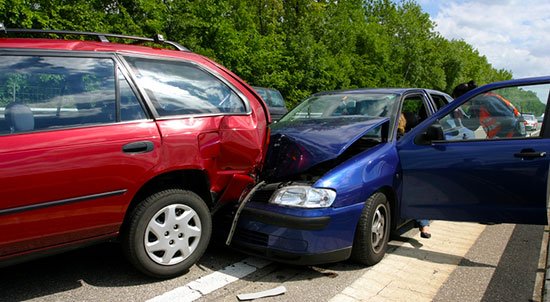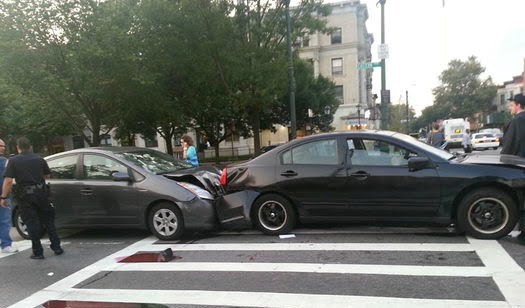
While rear-end car accidents occur frequently, they’re not any less damaging. And since it’s the driver following you that bumps against your rear end, there’s only so little, you can do to minimize the possibility of being in a rear-end collisions. Drover distraction causes 90 % of rear-end collision. Statistics from the National Highway Traffic Safety Authority paint the following spine-chilling scenario:
- Rear-end bumps makeup 29 % of all automobile accidents on American roads and injure about 556,000 people annually.
- The majority of rear-end collisions occur when the tailing car fails to maintain a safe distance and therefore rams into the vehicle in front when it suddenly stops or even slows down.
- Rear-end collisions are frequent during daytime and on dry, straight level roads
- Apart from tailgating, other causes of rear-end crashes are distracted driving. DUI, visibility issues due to bad weather, sudden breaks,
- Drover distraction causes 90 % of rear-end collision
- Males between 25-34 years were 1.9 times more likely to be involved in a rear-end collision.
- From soft tissue injuries to significant bodily harm, rear-end collision damages include stiff necks, shoulders, spinal injuries, concussions, and traumatic brain injuries, bruised shoulders, broken cheekbones and jawbones, etc.
- Apart from physical injuries, there’s the emotional trauma that comes with such unexpected horrors.
Serious surgeries, therapies, medications, and psychological treatments may be required to deal with injuries from a rear-end collision. And since you are incurring physical and mental harm due to someone else’s negligence, why not seek compensation?
Take Legal Action:
Knowing your rights always is a good thing. After a vehicle accident, you should always expect to be compensated for the damages done to your property and body. In most rear-end collisions, the fault solely lies with the driver who rammed into your rear end. Therefore, you should swiftly move to defend your rights and hold the careless driver responsible for rear-end collision damages depending on your state’s insurance laws.
1. No-Fault Insurance State
In states with no-fault insurance laws, it doesn’t matter who is at fault for the rear-end collision: You are to file the claim with your insurance company after the accident.
No-fault means you are rarely allowed to pursue the at-fault driver for compensation. Instead, have Personal Injury Protection. You can only sue the at-fault driver for first-party benefits if the damages exceed the no-fault threshold.
2. Outside a No-Fault State, i.e. a Tort State
If you live outside a no-fault state, you can fully hold the at-fault driver responsible for rear-end collision damages. You are not required to have a personal Injury Protection as part of your auto insurance. Just file the claim with the negligent driver’s insurance company.
Some states use the no-fault laws; others use tort laws and others a combination of both. The point is, the services of a rear-end collision specialist such as an experienced car attorney can help you know where to seek compensation and what amount to ask for.
Always Be Prepared to Prove the Rear-End Collision Damages
So, whether in a no-fault, tort or comparative negligence law state, you’ve decided to pursue the driver at-fault for rear-end collision damages compensation? Well, be prepared to prove the losses incurred.
Always start by reporting the incident to the police. While a police report is not a requirement when filing an injury claim, it helps document the damages — call 911. Next, gather evidence if you’re physically able to do so. Take photographs and videos of the incident: every vehicle in the incident, debris, damage, injuries, traffic lights, etc. Gather statements, names, contacts, and signatures of those who witnessed the accident and are willing to talk, even drivers. You can also record these statements. Seek medical attention – Don’t delay to seek medical attention. The medical report will help prove the injuries suffered and severity. Just make sure not to use your doctors who may balloon your bills with unnecessary excessive tests and spurious treatments. Prepare a detailed report using the photographs, videos, witness statements, medical records police opinion, any citations police issued to the at-fault driver, any arrests made, etc. Depending on how complicated your claim is, you can choose to seek the services of experienced car accident lawyers. Mostly the injury compensation is a sum of medical bills plus direct medical and non-medical expenditures, lost wages, and reasonable compensation for pain and emotional suffering. Complex claims, on the other hand, involve traumatic brain injuries, wrongful deaths, spine injuries, etc., seek the services of a skilled attorney.
What if you are the one at fault in a rear-end collision?
While mostly the driver who rams into your car from behind is at fault and compensation matters are quickly hashed out, in other cases, you’re partly to blame for the accident and compensation is not straightforward. For example, in instances where your brakes fail to indicate that you are slowing down or stopping. How do you go about seeking compensation then?
Ever heard of comparative negligence? Here, you’re still allowed to pursue the driver who rammed into your car from behind, even if you’re partly responsible for the damages. An insurance adjuster, however, reduces the compensation proportionally to your part of the blame. Here too, seek out a rear-end collision specialist to verify that you are receiving what you’re owed.
When is the driver who rams into you not liable for rear-end liability?
It’s not always that the one who rear-ends your car is at fault. Exceptions to the rear-end liability include:
- If your careless driving made it impossible for the one driving behind you to avoid the collision even with the safe distance in place.
- If no indications of sudden stops were given
- If adverse weather made it impossible for the driver behind you to stop. For example, lots of snowing, fog, rains, etc. lead to slick roads and visibility problems.
- If, while following at a safe distance and speed, the car behind you was forced to ram into your rear.
With the above tips, you know what to do if you are involved in a rear-end collision then, don’t you?
Read Also:






























